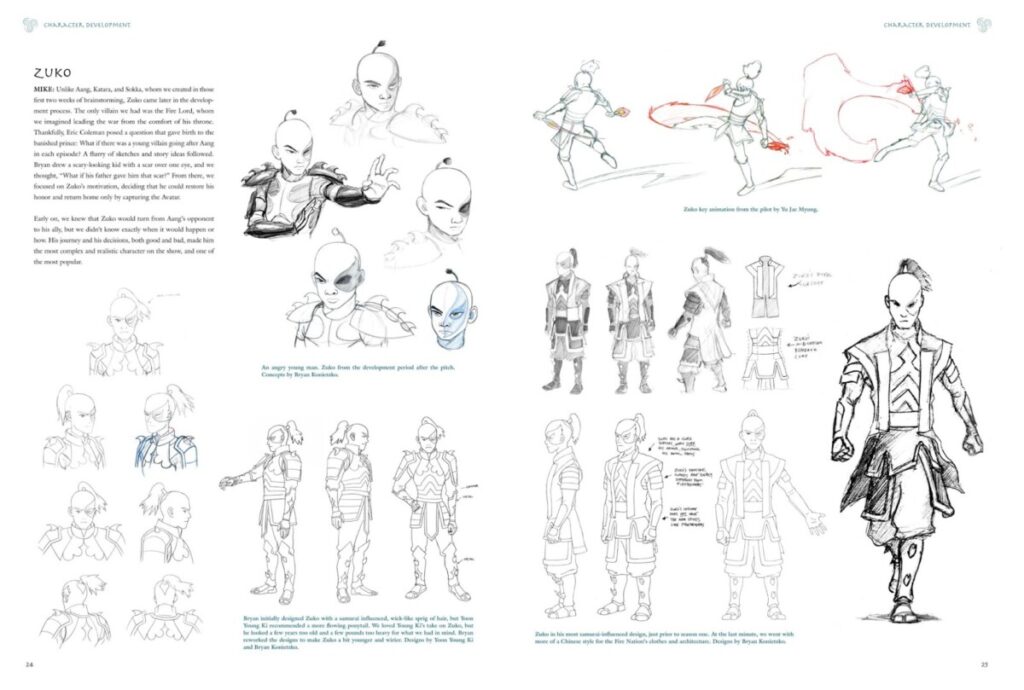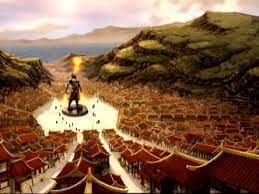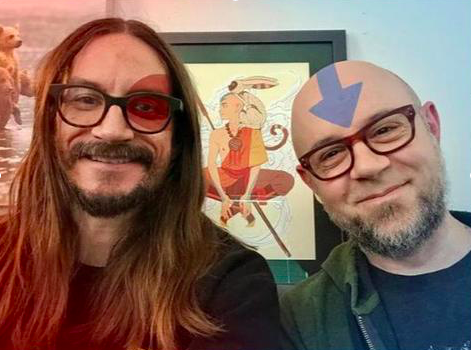
Chapter 1: Introduction To My Favorite Artists
Who Are They?
I would like to thank the creators of Avatar: The Last Airbender series, Michael Dante DiMartino and Bryan Konietzko, for inspiring my art. Michael Dante DiMartino is an American animation director who is famously known for being the executive producer and story editor of the hit Nickelodeon television series Avatar: The Last Airbender and The Legend of Korra. He is also the co-chief creative officer of Avatar Studios, a production company that works on Avatar franchise products.
How Did Their Partnership Start?
DiNartino began his art training at the Rhode Island School of Design, graduating in 1996 with Bachelor of Fine Arts degree from the Film and Animation Department. Mike later helped direct King of the Hill, Family Guy, and Mission Hill in addition to his own animated short, Atomic Love, which was screened at a number of high-profile film festivals, including the 2003 Sundance and Los Angeles Film Festivals. Bryan Konietzko graduated with a Bachelor of Fine Arts degree in Illustration from the Rhode Island School of Design in 1998, where he met Michael Dante DiMartino. In 2002, DiMartino teamed up with co-worker Bryan Konietzko to create Avatar: The Last Airbender, an Emmy award-winning American animated children’s television series that aired on Nickelodeon for three seasons, from February 2005 to July 2008. The show is known for its ingenious character development, innovative fighting scenes, and unique world-building.
Chapter 2: Character Design
Aang
I am fascinated by how meticulous the character design of the main characters of the show are. The characters were developed so perfectly that no character seemed out of place to the point where it could hinder the understanding of the show. We will start with the character Aang, the protagonist or hero of the show responsible for saving the world. In developing Aang, the creators were interested in a hero who came from an era of peace and has found himself in the future where the world is torn in war.
The creators wanted Aang’s clothing to reflect that he’s from a lost civilization that disappeared a century ago due to genocide. It was perfect to combine inspiration from Buddhist and Tibetan cultures to demonstrate that Aang is from a tranquil and ancient time. They also made him a young 12 year old boy so that children, the audience the show was designed for, can relate to him growing, learning and experiencing new adventures throughout his journey of maturing.
The creators were heavily influenced by a DVD called Shnolin: Wheel of life, where a young adolescent Shaolin monk performed kung fu and insane acrobatics. They wanted Aang to be a playful, cute, and fun loving kid who is highly skilled in martial arts. Thus, they made Aang bald with traditional Air nation tattoos similar to Tibetan monks, and dressed him in a saffron robe based off of those of Shaolin Buddhist monks, along with loose fit pants to give him more room to do air bending tricks.
As the creators were researching nicknames for Aang, they came across the Hindu word Avatar which means “the incarnation of the Spirit of the Planet in human form”. Aang is supposed to be a reincarnation of a spirit that brings peace and light to the world through element bending, he is therefore responsible for diminishing all evil and creating a balance in worldly disputes.
Katara
I believe it’s important to mention the creation of the characters that helped Aang throughout his journey in saving the world from the dictatorship of the Fire Nation. Katara is the heart of the show, meant to represent hope, passion, and love. The writers were persistent on establishing a strong female character as part of the main group of the Avatar gang. They made Katara the only surviving water bender in the South Pole Water Tribe.
Inuit and Yupik culture inspired the Water Tribes, which can be seen in their animal skin and fur clothing, much like the Inuit’s anoraks and mukluks, to protect themselves from the cold. Katara is dressed in very feminine style clothing like a blue dress over a pair of navy pants, as well as designed in a braided hairstyle to show how uptight and responsible she can be. She is especially made to be slightly older than Aang but not by too much so she can relate to the younger audience while protecting Aang as if he were her own little sibling.
Katara often acts as a caretaker to the other characters, providing them with emotional support, healing, acting as a moral compass and doing a lot of the cooking and sewing required for their journey. This is a result of an upbringing where she had to take on a lot of responsibility after the death of her mother, while growing up in a culture where gender roles seem to be pretty rigid. When in battle her long hair is revealed while her dress contains a slit in order to reveal that she has loosened up for the fluid water bending movements she will be needing for the fight.
Sokka
Her brother Sokka, who is presented as the sarcastic comic relief of the show, was also sketched at the same time as Katara on purpose to have an interesting sibling rivalry dynamic. They removed any bending powers from him so that he can start off as an inexperienced kid that transformed into a smart strategic warrior. They designed him to have bandages around his arms and knee pads to indicate that he is prepared or shielded from any physical fist fights he will encounter. His hair is tied in a ponytail so that he can seem strict and stern like a commander or leader. He carries a boomerang as a weapon, which is an unusual weapon of choice, but it conveys his very funny ridiculous nature. When in warfare, he is often drawn in black, white, grey Native American inspired war paint. Not only does it intimidate opponents, this disguise helps the warriors blend into the icy landscape of their polar homes. In the Northern Water Tribe, it is also customary for the chief to ceremonially apply three red markings to the forehead of chosen warriors departing on a dangerous mission.
Toph
The last two characters of the Avatar gang, Toph and Zuko, are my absolute favorite characters of the whole series. Toph was originally going to be a tough, brash, blind teenage boy who will be Aang’s earthbending teacher. They decided to change Toph’s gender to female, which is the best decision the creators have made. Not only did they make one of the strongest earth bender’s in that universe have a disability, they changed her into a 12 year old girl to challenge the gender stereotypes of girls being fragile and weak. Toph is seen in fighting gloves, a heavy belt around her waist to represent her durability and strong core strength, and loose pants for movement. It is significant to point out that she removes the bottoms of her shoe so that her feet can feel the ground. Since she is blind, she senses her opponent’s actions by listening and analyzing the vibrations of the ground.
Zuko
Zuko is another harsh or mean character that is beloved by everyone in the avatar fandom. Zuko is known to have the best redemption arc in tv history. His character design went through constant development as his character was going through a journey of finding himself and his purpose away from his family’s expectations. Zuko was introduced to us as a typical villain. He was ruthless and violent, and catching the Avatar was the end game to him restoring his honor. However, as the series progresses, we learn more about Zuko’s backstory, which helps us to understand why this character is the way he is. Zuko was just 13-years-old when he was banished from the Fire Nation and his father, Fire Lord Ozai, was the one responsible for the burns on Zuko’s face. When he finally makes the decision to turn his back on the Fire Nation and join Team Avatar, Zuko’s true self begins to show. Connecting and forming friendships with the Avatar Team was the first time in Zuko’s life where he wasn’t fighting for his father’s acceptance and approval; he finally became his own person.
In the beginning, Zuko wore a Top-knot hairstyle, a traditional hairstyle in many East Asian countries, signifying honor in the Fire Nation. The cutting off of a person’s top-knot was a crucial event in traditional Japanese culture. The removal of one’s top-knot, voluntarily performed by Zuko, was considered a renouncement of title, social status, and pride. He began his self journey after cutting off his top-knot and letting his hair grow out to the style he wanted, therefore demonstrating that he decided to abandon his nation. The Fire nation attire is based on Chinese influences. Zuko in particular, can be seen wearing a shenyi, a historical Chinese clothing.
- Check out the book written by Bryan Konietzko: Avatar, the Last Airbender: The Art of the Animated Series
- For more information on the characters, watch the Youtube Video: One Reason Avatar’s Characters Feel So Real
Chapter 3: Martial Arts Inspiration

Water 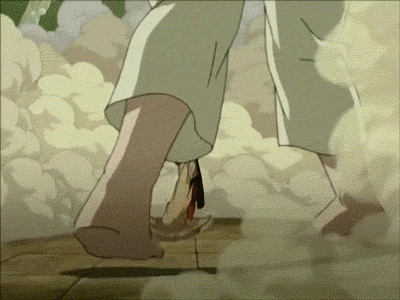
Earth

Air 
Fire
Water
The entrancing element bending of Avatar the Last Airbender was inspired by actual martial arts fight styles. Water bending is inspired by Tai Chi, a softer style of martial arts, characterized more by control than aggression. Tai Chi is less about strength and more about alignment, body structure, breath, and visualization. In Taoist philosophy, water is also associated with Yin, which means it is more peaceful, relaxed, and easygoing.
Earth
Earth bending is influenced by Hung Gar, a style of Southern Kung Fu that has roots in the Shaolin teachings. Hung Gar is known for strong stances and rooting to the ground. The fighting style contains strong kicks and punches that evoke the mass and power of earth. Toph is assigned her very own style. Her personal earthbending is inspired by Chow Gar Southern Praying Mantis. The aggressive, close-range style would best suit the blind earthbender. The fighter must fight in close contact with their opponent in order to predict their next moves. Much like Toph sensing the movements of her opponents through her connection with earth, a fighter learns to detect their opponent’s upcoming move by maintaining constant contact between their own arm and their foe’s arm.
Fire
Firebending is influenced by the Northern Shaolin fighting style. It is a very strong, dynamic, and explosive style. It uses powerful hand and leg movements. In Taoist way of thinking, fire is associated with Yang, meaning it is more aggressive, active, ambitious, and energetic.
Air
Lastly, Airbending is most closely related to Bagua martial arts. Bagua fighters are known for moving in a circle and constantly spinning back and forth. Aang’s circular movements can generate tornados or severe wind patterns that would knock an opponent off their feet.
- Check out an article posted by COMBAT MUSEUM: What Martial Arts Are Used In Avatar: The Last Airbender?
- For more information on the combat styles used in the show, watch the Youtube video: How ‘Avatar: The Last Airbender’ Animated Its Realistic Fight Scenes | Movies Insider
Chapter 4: World Building
The world building, specifically the architecture, in Avatar: The Last Airbender is influenced by different Asian cultures and buildings constructed in the real world. Every nation uses distinct materials to assemble buildings, such as metal, stone, and ice, depending on the specific climate of each nation and locally available resources.

Southern Air Temple 
Eastern Air Temple 
Western Air Temple
Air Temples
Air Nomads believed in peace and harmony in the world, which was positively reflected in their architecture. Air temple architecture draws from real life Chinese Buddhist Pagodas. The air temples were generally composed of towers and pagodas isolated on tall mountains, or hanging off of cliffs.

Northern Water Tribe 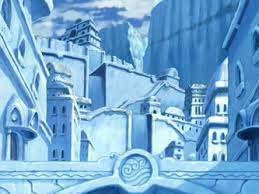
Northern Water Tribe 
Southern Water Tribe
Water Tribes
The Northern Water Tribe’s architecture pulls from the ancient Aztecs’ pyramids and Venice’s canal systems, while the Southern Tribe’s igloos mirror those of the Inuit. In the Southern Water Tribe, houses are supported by wooden branches with animal skins to cover them. The Northern Water Tribe constructions are made of ice, including buildings, bridges, and sculptures.
Earth Kingdom
Much of Earth Kingdom’s architecture reflects China. The capital, Ba Sing Se, draws many parallels with ancient Chinese capitals such as Beijing. The royal palace in Ba Sing Se is directly influenced by the Forbidden City in China. The walls of Ba Sing Se are an exact replica of the Great Wall of China. The majority of the buildings are made of stone, cement, and rock built by earth benders.
Fire Nation
The Fire Nation’s topography is also similar to Japan, Hawaii, and Polynesian Islands. Ancient Egyptian and Chinese architecture inspired the Fire Nation Royal Palace. The Fire Nation follows the Chinese architectural feature of yellow roof tiles/roofs indicating an imperial building. The roof tiles also resemble flames to represent the main element of bending their nation utilizes.
- Check out the article written by AVATAR WIKI: Architecture in the World of Avatar
- If you want to learn more about the avatar world, watch the Youtube video: Avatar: The Last Airbender – Realistic Fantasy
Chapter 5: Conclusion
How Was My Art Influenced?
I am very grateful for the creators Michael Dante DiMartino and Bryan Konietzko for carefully and meticulously producing one of my favorite shows of all time, Avatar: The Last Airbender. Every single detail of the main characters were purposefully planned to make the show relatable, yet engaging. Each character style reflects their personality traits as well as their emotional development or self-journey. I hope to create characters as complex and eccentric as the main protagonists of the show, where the audience finds it difficult to choose their favorite character. I love the fluidity, motion, and emotions involved in element bending. I can only hope my art can achieve such dynamic movements presented in Avatar. The show combines cultures in order to fabricate a whole new culture. We learn about this new avatar culture or world by watching the adventures and explorations of the main characters. It is significant to plan a well developed world as the character’s environment contributes to their emotional and spiritual growth. I will further take notes on how to world-build through this cartoon, as I appreciate the originality of the avatar dimension.





